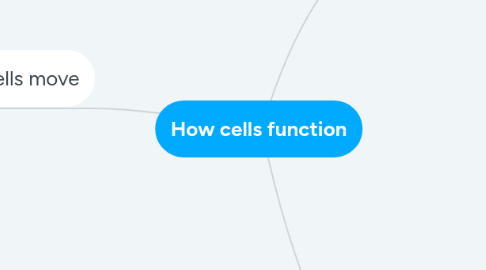
1. How cells move
1.1. Transport
1.1.1. Passive transport: The movement of materials through a membrane without any input of energy.
1.1.1.1. Diffusion: The tendency of a substance to move from an area of higher concentration to an area of lower concentration. Small molecules, such as oxygen, can pass through tiny gaps in the cell membrane by diffusion.
1.1.1.1.1. Osmosis: The diffusion of water through a membrane
1.1.2. Active transport: The process of using energy to move materials through a membrane.
1.1.2.1. Exocytosis: a membrane within the cell encloses the material that needs to be removed. This package moves to the cell membrane, joins with it, and the material is expelled.
1.1.2.2. Endocytosis: occurs when a large bit of material is captured within a pocket of the membrane. This pocket breaks off and forms a package that moves into the cell.
1.1.3. Cell size
1.1.3.1. if cells were not so small, they could never do their jobs.
1.1.3.2. As the cell gets bigger, there comes a time when its surface area is not large enough to allow resources to travel to all parts of the cell. So, the cell stops growing.
2. Molecules of life
2.1. All matter in the universe—living and nonliving—can be broken down into basic substances called elements. Of all the elements found on Earth, about 25 are essential for life.
2.1.1. Chemical reaction: The process by which chemical changes occur. In a chemical reaction, atoms are rearranged, and chemical bonds are broken and formed.
2.1.1.1. Cells use chemical energy for activity
2.2. Large molecules support cell function. Thousands of these molecules work together in a cell. They all contain carbon atoms.
2.2.1. Carbohydrates
2.2.1.1. Used for structure and energy storage.
2.2.1.2. Made up of sugars
2.2.2. Lipids
2.2.2.1. Make up the membranes surrounding the cell and organelles.
2.2.2.2. Made up of fatty acids and glycerol.
2.2.3. Nucleic acid
2.2.3.1. Store and translate the genetic information a cell needs to function.
2.2.3.2. Made up of nucleotides.
2.2.4. Proteins
2.2.4.1. Carry out most of the chemical activity in cells.
2.2.4.2. Made up of amino acids.
2.3. Water
2.3.1. About 2/3 of every cell is water.
3. Cell energy
3.1. All cells need energy to keep on working
3.1.1. Chemical energy: Energy that is stored in the chemical composition of matter. The amount of chemical energy in a substance depends on the types and arrangement of its atoms.
3.1.2. Glucose: A sugar molecule that is a major energy source for most cells, produced by the process of photosynthesis.
3.1.2.1. Plants do not immediately use all of the glucose they make. Some of the glucose molecules are linked together to build large carbohydrates called starch. Plants can store starch and later break it back down into glucose or other sugars when they need energy.
3.1.2.2. Can also be stored as glycogen.
3.2. Energy from sunlight is used by most cells
3.2.1. Photosynthesis: The process by which green plants and other producers use simple compounds and energy from light to make sugar, an energy-rich compound.
3.2.2. Chlorophyll: A light-absorbing chemical, a pigment, that traps the energy in sunlight and converts it to chemical energy. Found in chloroplasts of plant cells and the cells of other photosynthetic organisms.
3.3. All cells release energy
3.3.1. Cellular respiration: A process in which cells use oxygen to release energy stored in sugars.
3.3.2. Fermentation: A chemical process by which cells release energy from sugar when no oxygen is present.

